Prionopelta seychelles
| Prionopelta seychelles | |
|---|---|

| |
| Scientific classification | |
| Kingdom: | Animalia |
| Phylum: | Arthropoda |
| Class: | Insecta |
| Order: | Hymenoptera |
| Family: | Formicidae |
| Subfamily: | Amblyoponinae |
| Tribe: | Amblyoponini |
| Genus: | Prionopelta |
| Species: | P. seychelles |
| Binomial name | |
| Prionopelta seychelles Overson & Fisher, 2015 | |
This species is known only from Seychelles and is found between 15–660 meters of elevation on the islands of Mahé, Conception, Thérèse, Silhouette, Praslin, La Digue, Félicité Island, and the Little Sister island group. It does not appear to have strict habitat preferences as it has been collected in mixed forest, littoral forest, non-native forest, palm forest, and coastal scrub. P. seychelles has also been collected from a diversity of microhabitats including from leaf litter, inside rotten logs, under rocks, under moss on live trees, and under root mats. (Overson and Fisher 2015)
Identification
Overson and Fisher (2015) - P. seychelles is the only known species from Seychelles. It can be distinguished from all other Malagasy Prionopelta through the following characters: twelve antennal segments; densely arranged cephalic foveae with virtually no space for additional foveae and no shining integument visible between; pronotum consisting of shallow foveae much larger in diameter than those on the head with punctures between; median cephalic band which is devoid of foveae not swelling above the surrounding integument, and often characterized as being wider anteriorly and narrower posteriorly.
P. seychelles is most likely to be confused with Prionopelta subtilis, as both have very small cephalic foveae that are densely arranged on the head. However, the two species are not sympatric, as P. seychelles is known only from Seychelles, and P. subtilis only from Madagascar. The median cephalic bands contrast markedly between these taxa, as that of P. seychelles is wide anteriorly, often tapering posteriorly, with an interrupted border caused by aberrantly placed foveae which break up the margins which define the smooth shining area. That of P. subtilis, on the other hand, is very thin throughout its length, with clearly defined borders which are swollen above the surrounding integument. On average, P. subtilis also has a wider head than P. seychelles: 0.39–0.45 (0.42) vs. 0.33–0.37 (0.35), respectively. Additionally, the cephalic foveae of P. subtilis are smaller and the cephalic sculpture overall appears more delicate than that of P. seychelles.
Keys including this Species
Distribution
Latitudinal Distribution Pattern
Latitudinal Range: -4.3258° to -4.6631°.
| North Temperate |
North Subtropical |
Tropical | South Subtropical |
South Temperate |
- Source: AntMaps
Distribution based on Regional Taxon Lists
Malagasy Region: Seychelles (type locality).
Distribution based on AntMaps
Distribution based on AntWeb specimens
Check data from AntWeb
Countries Occupied
| Number of countries occupied by this species based on AntWiki Regional Taxon Lists. In general, fewer countries occupied indicates a narrower range, while more countries indicates a more widespread species. |

|
Estimated Abundance
| Relative abundance based on number of AntMaps records per species (this species within the purple bar). Fewer records (to the left) indicates a less abundant/encountered species while more records (to the right) indicates more abundant/encountered species. |

|
Biology
Castes
Worker
Images from AntWeb
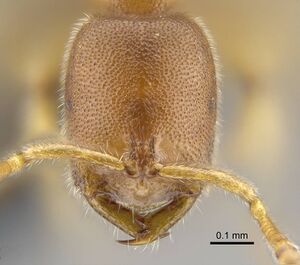    
| |
| Holotype of Prionopelta seychelles. Worker. Specimen code casent0161311. Photographer Rick Overson, uploaded by California Academy of Sciences. | Owned by CAS, San Francisco, CA, USA. |
  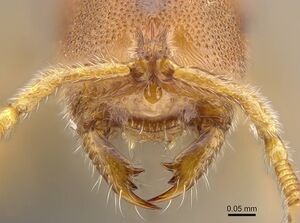  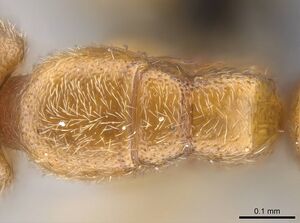 
| |
| Paratype of Prionopelta seychelles. Worker. Specimen code casent0161319. Photographer Rick Overson, uploaded by California Academy of Sciences. | Owned by CAS, San Francisco, CA, USA. |
Queen
Images from AntWeb
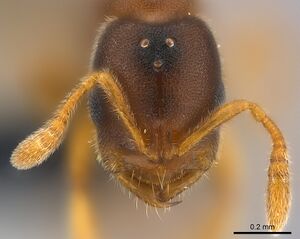   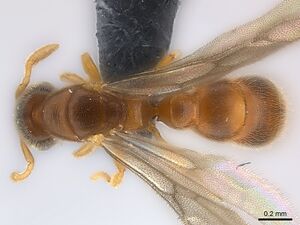 
| |
| Queen (alate/dealate). Specimen code casent0160375. Photographer Erin Prado, uploaded by California Academy of Sciences. | Owned by CAS, San Francisco, CA, USA. |
Male
Images from AntWeb
  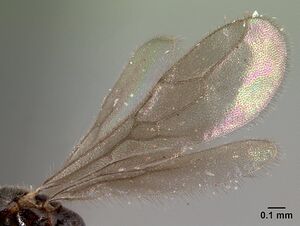  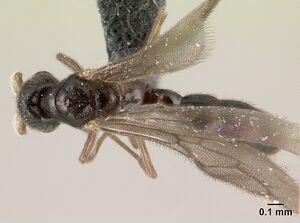 
| |
| Male (alate). Specimen code casent0160800. Photographer Erin Prado, uploaded by California Academy of Sciences. | Owned by CAS, San Francisco, CA, USA. |
    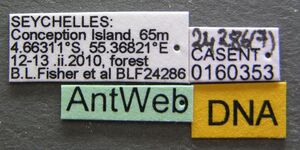
| |
| Male (alate). Specimen code casent0160353. Photographer Erin Prado, uploaded by California Academy of Sciences. | Owned by CAS, San Francisco, CA, USA. |
Nomenclature
The following information is derived from Barry Bolton's Online Catalogue of the Ants of the World.
- seychelles. Prionopelta seychelles Overson & Fisher, 2015: 132, figs. 3C, 8 (w.) SEYCHELLES IS (Silhouette I.).
- Type-material: holotype worker, 8 paratype workers.
- Type-locality: holotype Seychelles: Silhouette I., ridge from Mont Corgat to Mont Cocos Marrons, 4.50126°S, 55.23985°E, 455 m., 24.ii.2010, BLF23364, CASENT0161311, forest, sifted litter (leaf mold, rotten wood) (B.L. Fisher, et al.); paratypes with same data but CASENT0161310, CASENT0161312 to 0161319.
- Type-depositories: CASC (holotype); BMNH. CASC (paratypes).
- Distribution: Seychelles.
Unless otherwise noted the text for the remainder of this section is reported from the publication that includes the original description.
Description
Worker
(N=15). HL 0.44–0.48 (0.46); HW 0.33–0.37 (0.35); SL 0.22–0.26 (0.24); WL 0.47–0.54 (0.5); PetL 0.13–0.17 (0.14); PetW 0.17–0.21 (0.18); T1W 0.29–0.31 (0.3); CI 73.63–80.41 (76.39); PI 106.92–144.44 (128.7); SI 64.56–73.43 (69.77).
Twelve antennal segments; posterior margin of the head weakly concave in full-face view; small cephalic foveae densely positioned so that no flat, shining integument is present between; median cephalic band which is devoid of foveae does not appear to swell above the surrounding integument, but rather appears as a smooth, shining surface which is widest anteriorly, narrowing posteriorly; apical tooth intermediate in length; pronotum with foveae which range from shallow to deep and are interspersed regularly with punctures; mesonotum and propodeum consisting of large, shallow foveae; metanotal groove strongly visible, and mesopropodeal suture visible to barely visible, but some depression always present; posterior propodeal edge viewed dorsally is straight or only very slightly concave; no protruding lamellae of the posterior propodeum.
Type Material
Holotype, pinned worker, SEYCHELLES, Silhouette Island, ridge from Mont Corgat to Mont Cocos Marrons, 4.50126°S, 55.23985°E, 455 m, for est, sifted litter (leaf mold, rotten wood), collection code BLF23364, 24.ii.2010 (B.L. Fisher et al.) (California Academy of Sciences: CASENT0161311). Paratypes, eight pinned workers with same data as holotype (The Natural History Museum: CASENT0161314; CASC: CASENT0161310; CASENT0161312; CASENT0161313; CASENT0161315; CASENT0161316; CASENT0161317; CASENT0161319).
Etymology
This species is named after the Seychelles archipelago, to which it is endemic. The species epithet is a noun in apposition, and thus invariable.

